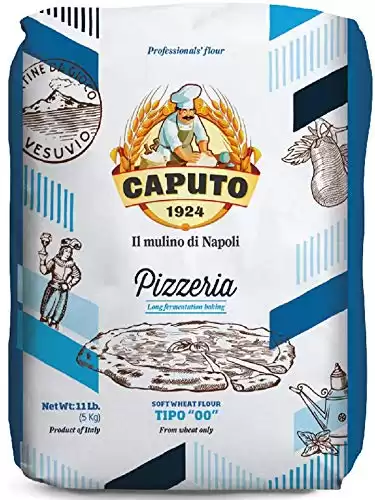Dough hydration is actually one of the more complex topics in pizza baking, but when you understand it, you can make exactly the pizza you’re looking for! Neapolitan pizza is hugely about the crust, and to get just the right crust, you have to understand hydration and how it affects your dough.
The best pizza dough hydration for Neapolitan pizza baked in a wood-fired
What Does Dough Hydration Mean?
Dough hydration is the amount of water in your dough in relation to the amount of flour. Hydration is usually expressed using baker’s percentages, e.g. 60% hydration.
Baker’s Percentages
Baker’s percentages might sound complicated, but it’s actually pretty simple. It’s a notation for the portion of an ingredient in the dough compared to flour in percentages. So if your recipe asks for 2% salt, it means the amount of salt in the dough should be 2% of the amount of flour. As an example: if your dough has 100g of flour, 2% salt will be 2g salt.
Dough Hydration – How Much Water Your Dough Contains
Dough hydration is Baker’s Percentages applied to water in the dough. So it simply means how much water your dough contains as a percentage of flour. I have an in-depth article on pizza dough hydration, that I recommend if you’re not familiar with the topic.
How to Calculate Pizza Dough Hydration
Before we talk more about hydration, it’s useful to know how to calculate it.
You calculate dough hydration just like any other ingredient using baker’s percentages. If your dough has e.g. 1000g of flour and 600g of water, it has 60% hydration.

Use a Dough Hydratiuo Calculator
To make this easier, I’ve made a dough calculator to help you calculate hydration for your Neapolitan pizza dough:
Pizza Dough Calculator.
The calculator also allows you to choose the weight of your dough balls and how many you want. I found this to be a headache, every time I wanted to experiment with dough size and hydration, so I decided to create this tool.
Measuring the Ingredians Accurately
One thing worth mentioning is that baking requires precision to get a consistent result. So make sure you’re accurate when you measure flour and water to get the right hydration. A small difference in ingredients can make a huge impact on the dough. I, therefore, recommend measuring ingredients by weight, rather than volume, since that’s more accurate.
If you don’t already own a digital kitchen scale, I highly recommend getting one. It’s going to improve the consistency of your baking tremendously!
You should also measure out all the flour you’re going to use before you start baking. And don’t add any more during kneading! This will alter the hydration.
How Hydration Affects Pizza Dough and Crust
I’ve talked a lot about what dough hydration is, but how does it actually affect the dough? What happens if you increase or decrease the hydration? And why is it so important for Neapolitan pizza to master dough hydration?
Hydration affects the dough in several different ways. But the most important ones are:
Stickiness of the Dough
Hydration affects how soft and sticky your dough is. The higher the hydration, the stickier the dough will be.
The Size of the Air Bubbles
Higher hydration will also increase the size of the air bubbles in the dough. The reason is more water will soften the gluten in the flour, allowing it to stretch into larger bubbles.
Gluten is a collection of proteins found in wheat flour. The primary task of gluten in pizza dough (and in any other dough, for that matter) is to keep the structure of the dough. When these proteins absorb water they start to form a network that makes the dough elastic and stretchy. The more water the gluten proteins absorb the softer and easier, the gluten network will stretch. And this is what allows larger air bubbles to form in the dough.
Click here, if you want to know more about gluten and how the magical process of gluten development can change your dough.
Oven Spring
Softer gluten, as a result of higher hydration, will also give the crust more oven spring. This means that the crust will puff up and get large and airy when you bake your pizza.
Oven spring is a result of the yeast getting the last boost when the temperature of the dough increases in the oven. That, combined with the water in the dough turns into steam. So the more water your dough contains, the more oven spring you’ll get.
Crispy Crust
This might sound counterintuitive, but higher hydration will make the exterior of the crust crispier. The reason is that softer gluten strands that stretch thinner will get crispier when you bake the pizza.
Soft Center of Crust
Higher hydration will also keep the interior of the crust moist and softer.
How Baking Temperature Relates to Hydration
Temperature and baking time are important because the same dough will result in different pizzas depending on how fast and hot it’s baked.
When baking pizza fast and hot, like in a wood-fired oven, it’s common to use a low-hydration dough. But in a cooler oven, such as a home oven, you need to bake the pizza much longer to achieve the same doneness. A longer time in the oven will dry out the dough more. So to get the same result in a cooler oven, you need more water in your dough to end up with the same pizza crust.
Neapolitan pizza is traditionally baked in a really hot wood-fired for 60-90 seconds. This short baking time is what gives the pizza its iconic crispy crust, that’s still soft and airy on the inside. Since Neapolitan pizza is in the oven for such a short time, the hydration has to be fairly low.
In a home oven, it’s a different story. Most home ovens can only reach around 500°F, which requires longer baking time. When the pizza is in the oven for a longer period of time, the dough will dry out more due to evaporation. The solution is to increase the hydration, so you will end up with the same moistness in the curst when the pizza is done.
The temperature at which you plan to bake your pizza at will affect how high hydration your dough should have.
What Is Neapolitan Pizza? (What We’re Trying to Make)
Neapolitan pizza should be a round disk with a raised edge and a thin base with condiments (sauce, cheese, and toppings). The edge, called conicione in Italian, should be crispy on the outside, charred, and have a light leopard pattern. But the interior of the crust should be soft and light, filled with large air bubbles.
Neapolitan pizza has a long history and even strict regulations, managed by the AVPN (The True Neapolitan Pizza Association).
A Neapolitan pizza should also be baked in a wood-fired oven at 905°F (485°C) for 60-90 seconds. This quick bake is also part of the secret to the unique crust of the Neapolitan pizza. The high heat is what gives the cornicione the iconic puff, or oven spring. It’s made from a lean dough, that only contains four ingredients: flour, water, salt, and yeast.

So that’s what we’re looking for! Neapolitan pizza is defined by its crust, so to re-create the perfect Neapolitan pizza, you need to be able to control the dough.
Hydration closely relates to the baking temperature. So If you bake Neapolitan-style pizza in a home oven, which can’t reach anywhere near 900°F, you need to adjust the hydration of the dough to account for the longer baking time.
Neapolitan Pizza Dough Hydration in Wood-Fired Ovens
In a wood-fired oven, there is not much time for the water in the dough to evaporate because it will be done so quickly. You, therefore, want to use low-hydration doughs in a wood-fired
To get the best possible result in a wood-fired oven, I recommend following the AVPN’s International Regulations for Neapolitan pizza. According to the standard, Neapolitan pizza baked in a wood-fired oven should have a dough hydration of around 60% (55.6-62.5%).
Neapolitan Pizza Dough Hydration for the Home Oven
In a home oven you will have a longer bake at a lower temperature, you therefore need to increase the hydration
A home oven isn’t going to bake Neapolitan-style pizza as well as a wood-fired brick oven. It simply can’t get hot enough. You can improve the result by adjusting the hydration, but you still want the oven to be as hot as possible. For most home ovens, the optimal pizza dough hydration is 65-70%.
How to Improve Baking of Neapolitan Pizza in a Home Oven
To get a result as similar as possible to a wood-fired oven, you want to bake the pizza as hot and fast as possible. The two most important things you can do to improve baking in your home oven are to use a pizza stone or
A wood-fired oven bakes pizza with a combination of heat from the floor and radiation heat from the dome of the oven. This means that the pizza is exposed to heat from below and above at the same time. With two heat sources, the pizza will bake quicker than with only one. To create a similar baking environment in your home oven, you can use a pizza stone or
Use a Pizza Stone or Pizza Steel
A pizza stone or a
They both work great and will make much crisper pizza, but personally, I prefer the
To learn how to use a pizza stone or
Use the Boiler
A great trick to increase the baking temperature in your home oven is to use the boiler or grill function. The broiler gets really hot and even allows you to get a proper leopard pattern on your pizza. It’s therefore something I always use when I bake pizza in my kitchen.
In combination with a pizza stone or
Check out this article on how to make leopard pattern on your pizza crust for a full guide to using the broiler.

Adjust the Hydration According to the Baking Temperature
The general rule of thumb is the lower the temperature you bake the pizza at, the higher the hydration needs to be in order to get the same result.
Here’s a table that shows what hydration will give you the most similar result to a 60% hydration dough in a wood-fired oven for different temperatures:
| Temperature in Fahrenheit | Temperature in Celsius | Hydration |
| 450°F | 230°C | 66% |
| 500°F | 260°C | 65% |
| 550°F | 285°C | 64% |
| 600°F | 315°C | 63% |
| 700-900°F | 370-485°C | 60% |
(These numbers are not scientific or 100% accurate, this is just meant as a guideline)
How to Work With High-Hydration Doughs
Working with high-hydration doughs can be challenging, but here are a few tips to help you out.
Use A Dough Scraper
A useful tool when you deal with high-hydration doughs is a dough scraper. High-hydration doughs tend to get very sticky, and really stick to your fingers when you knead it. But using a dough scraper to manipulate the dough rather than your hands is going to make your life a lot easier!
It’s also a very inexpensive tool, you can pick it up at Walmart or Amazon for a few bucks.
Avoid Sticking to Your Hands While Kneading
To prevent a high-hydration dough from sticking to your hands, I recommend dipping your hands in water before you work the dough, rather than flour. Just be careful not to add too much water to the dough, as this will effectively increase the hydration.
Avoid Sticking to the Pizza Peel
One of the biggest challenges when you work with high-hydration dough is that it sticks to the
To prevent sticking, I recommend preparing and topping your pizza on the countertop to minimize the time on the peel. The longer your pizza is on the peel, the more likely it is to get stuck.
I also recommend drizzling semolina on your peel before you move the pizza onto it.
Using the right type of peel will also help prevent sticking. Here’s an in-depth article on the best non-stick pizza peels and how to prevent the dough from sticking to the peel.
Neapolitan Pizza Dough Hydration and Flour
The type of flour you use is also important when it comes to hydration. The reason is that the properties of your dough hugely depend on the gluten content and its ability to absorb water.
Water Absorption in Pizza Flour
Different types of flour have different abilities to absorb water. This means that if you add exactly the same amount of flour and water to your dough, but you use two different types of flour, the dough can be different. Even though they technically have the same hydration (when you do the math), it will seem like the hydration is different due to their different abilities to absorb water.
Therefore, you should be aware that you have to account for absorption when you try a new flour or follow a recipe in a cookbook or online. I, therefore, recommend always starting with around 65% hydration and seeing how the dough turns out so you have a baseline. Then you can experiment from there!
Absorption and all the other complex aspects of hydration are explained in the article: Pizza Dough Hydration Explained.
The Best Pizza Flours for Neapolitan Pizza
“When in Rome do as the Romans do“, the same goes for Naples. I therefore always recommend using high-quality Neapolitan pizza flour if you want to make Neapolitan-style pizza.
My go-to is Antimo Caputo. This is a Naples-based flour mill that has made flour for the local pizzerias for generations. They are also an approved supplier by the AVPN, so if you want to make proper Neapolitan-style pizza, Antimo Caputo is definitely the day to go!
They have a variety of different flours, but one of my favorites is Caputo Pizzeria.
How to Adjust Hydration to Create Your Perfect Dough
There is no perfect pizza dough hydration, it all depends on the flour you use, the temperature you bake the pizza at, and what kind of dough you’re looking for. But to know how hydration affects the dough is the key to getting the perfect dough. And I strongly encourage you to experiment, with hydration. But here are a few things you can adjust with dough hydration to get you started.
| Higher Hydration | Lower Hydration | |
| Crispiness | More crispy | Less crispy |
| Air Bubbles | Larger | Smaller |
| Oven Spring | More | Less |
Crispiness
To increase crispiness you have to increase the hydration of your dough. The reason is that with higher hydration, the gluten strands get softer and can be stretched more. Then the gluten strands stretch thinly, they will get crispier when you bake them.
Similarly, to reduce crispiness, you need lower hydration. Then the gluten strands will get thicker and less crispy when you bake them,
Size of the Air Bubbles in the Crust
The size of the air bubbles in the crust (cornicione) depends on two things: gluten and hydration.
To create larger air bubbles, you want lower gluten development and higher hydration. The reason is that softer gluten will stretch more easily and create larger bubbles. To soften the gluten you can increase the hydration.
If you want smaller air bubbles in the crust, you should have more gluten development and lower hydration.
Oven Spring
Oven spring, or puff, is closely related to the size of the air bubbles. Then gluten is softer, it will give the dough more oven spring when exposed to high heat. You, therefore, lower gluten development and higher hydration will increase the oven spring.
Neapolitan Pizza Dough Hydration Recipes
When it comes to dough, I recommend sticking to the Authentic Neapolitan Pizza Dough Recipe (based on the AVPN International standard) and adjusting the hydration to the baking temperature and time you’re planning to use.
- Ooni Turning Peel Review: The Best Peel for Home - April 15, 2024
- Gi.Metal Turning Peel Review: Is This the Ultimate Pizza Tool? - April 14, 2024
- Discover Pizza Mastunicola: The Story of the First Pizza - April 7, 2024


Comprehensive article, thanks!